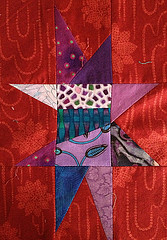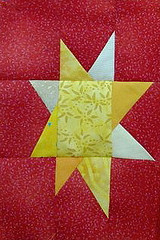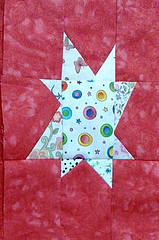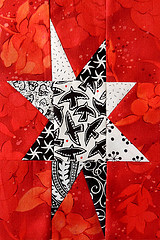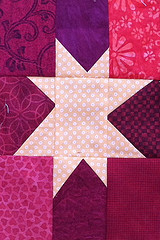I did not grow up in a family with a quilting tradition–my mother sewed garments and saved all the scraps from the clothes she made for me and my siblings and always talked about quilting. While she did make a cathedral window quilt for me as a wedding gift–sewn completely by machine–using many of those scraps, it was the beginning and end of her quilting experience.
So, how did I become a quilter?

 I can't remember exactly what sparked the idea of making a quilt when I was a teenager, but I do remember the attempt. I used this book and chose to make a Drunkard's path quilt. The book, Award Winning Quilts, by Effie Chalmers Pforr, was published in 1974 and includes patterns for winners in a quilt block competition.
I can't remember exactly what sparked the idea of making a quilt when I was a teenager, but I do remember the attempt. I used this book and chose to make a Drunkard's path quilt. The book, Award Winning Quilts, by Effie Chalmers Pforr, was published in 1974 and includes patterns for winners in a quilt block competition. One of the requirements of the contest was that the block had to be completely stitched by hand! All the pieced block patterns include templates and the book describe how to create templates from sandpaper.
I remember that my first attempt at quilting began with this book and block pattern. I started with one block–made in a combination of blue and orange solids. Mine was not stitched by hand–I knew how to use a sewing machine and used one. But I never got past that first block. It became a lovely, graphic pillow cover ... and I didn't think about quilting again for a couple of decades ... although, like my mother, I sometimes bought fabrics for a one-day quilt.
While living in a small community in the California Wine country, my interest in quilting was sparked again and a chance meeting with a friend-of-a-friend, who taught quilting and became my quilting friend. I don't have most of my early quilts because they were made for gifts for my family, but I do have my first quilt, made in a paper foundation piecing class taught by my friend.
 When I took this class, I had no quilting fabrics and wasn't quite ready to invest in any–I showed up at class with two cotton shirts. A fellow classmate gave me the white-on-white that I used for the inner border on this little 12-inch quilt.
When I took this class, I had no quilting fabrics and wasn't quite ready to invest in any–I showed up at class with two cotton shirts. A fellow classmate gave me the white-on-white that I used for the inner border on this little 12-inch quilt.Being a geek, as soon as I started quilting, I went online, looking for quilting information and found online communities of quilters discussing quilting and swapping fabrics and quilt blocks. I think I signed up for two swaps on my first day. The 4-inch wide strips and 10-inch squares that I swapped became the basis for my scrappy stash.
 As I flipped through the blocks in the book again, lately, I realized how much those with curved elements appealed to me from the beginning. I thought it was time to think about that Drunkard's Path pattern again.
As I flipped through the blocks in the book again, lately, I realized how much those with curved elements appealed to me from the beginning. I thought it was time to think about that Drunkard's Path pattern again. This time, I didn't make templates and carefully cut the fabrics with scissors ... I used a die to cut the pieces from a charm pack of Stonehenge fabrics and some mottled batik, with the idea of creating a stone path.
A package of 36 charms plus background became seventy-two 3 1/2-inch square Drunkard's path units. The little notches in the die made it easy to line things up when I sewed them together.
I played on the design wall, arranging, rearranging and playing with proportions before sewing them together into the 21-by-42 inch panel above.
I have some ideas about what comes next in this quilt design ... stay tuned.
If you would like to share a link to your quilting origin story, join in the linky party below. (I'm sharing this list with the Block Lotto Weekend update, so you only need to add your link in one place.)























